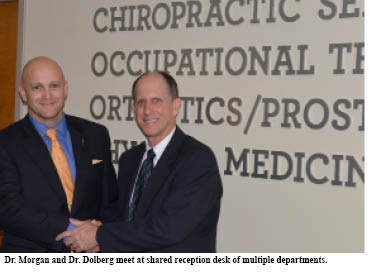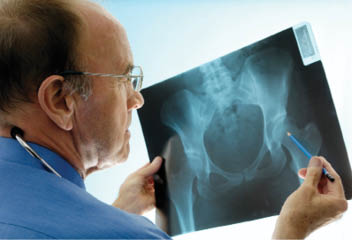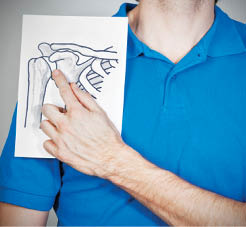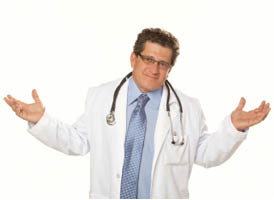:dropcap_open:R:dropcap_close:on walks through his department, musing at the firmly presented evidence of new plans and projects displayed on a large wall-mounted flat screen TV. At ChiroTouch, it’s all about transparency. Every employee must be able to quickly tour the office and gain a firm grasp of the latest projects. In this way, they all stay connected. His team is responsible for helping him fortify yesterday’s foundation, and pioneer the next step in the never-ending quest for innovation.

He unlocks his office door and casually flicks on the lights. The scene has changed over the years – from a small computer in his home, to a desk in a one-room office, to one in a large suite fit to support a full-fledged company, to this room; where a wraparound desk holds his various technologies, and plaques of accomplishment adorn the walls. Success is palpable in the halls around him as the buzz of activity continues to build. The rise of ChiroTouch has gained momentum, but for Ron the objective is the same: to make an outstanding piece of software.
One room to the right of Ron’s decorated office, his cohort Robert Moberg stands at the head of a large conference table behind a glass wall. He references a large monitor that displays one of his highly intricate spreadsheets (for which he is well-known throughout the company’s many diverse departments) and discusses the numbers as they relate to current happenings and far-reaching future plans.
“And what do we do, in all that we do?” he asks his team, pausing with an encouraging smirk, “We consistently try to find ways to make it work, or make it better.” He instills this value into every employee, helping them find their own strengths, harness their individual creativity, and apply themselves ceaselessly to each and every new challenge.
As Co-founder, Developer, and Chief Technology Officer of Integrated Practice Solutions, Ron McNeill established ChiroTouch through hard work, perseverance, and sometimes just plain stubbornness. The grassroots foundation was born in 1999 out of a single chiropractic provider’s request for an interface that would allow him to search through his patients by name. From this small application grew a full practice management solution unlike anything the chiropractic market had seen. Ron harnessed cutting-edge technology to build a solution that streamlined provider processes with touch screen interfaces, barcode and fingerprint scanner integration, and streamlined patient flow management. As a direct result of the heartfelt effort and continued innovations he’s instituted within the software, including industry-exclusive offerings of iPad integration and mobile phone patient communication portals, ChiroTouch has grown over time to become the industry standard for the chiropractic market.
But not all of this success came without its hard times, which are evidenced in the stories he is prodded to recant at every yearly meeting to help new employees understand the heart of the company. It’s an important initiation for newcomers, and a reminder for others that they must understand, at a very personal level, the special endeavor in which they’ve been invited to participate.
Success also did not come overnight, and for the first 5 years, providers were hesitant to adopt a new system within their practice which meant ChiroTouch users were few and far in between. But even throughout a barely-climbing client count, Ron forged ahead. He queried his users for input, provided them with tireless support, and diligently stationed himself at every trade show. Now one of the largest booths in attendance, ChiroTouch was once nothing more than a small table, one chair, and one man with a lot of drive and perseverance. And from those experiences, he now reminds his staff that it’s important to respect every player within the industry.
“When you go to a tradeshow, watch for the little guy in the corner and realize that he may not look like much. But I was once that little guy in the corner, and now look around you at what we’ve built.”
In 2004, Ron partnered with his then-client, a well-respected Seattle chiropractor, Dr. Michael Failla. Under Dr. Failla’s charismatic and enthusiastic watch, ChiroTouch began to find its way into chiropractic offices across the country. Dr. Failla’s own testimony and particular empathy with the challenges of running a high-volume practice helped him encourage his fellow peers to decrease their practice expenses, increase their efficiency, and get back to the most important part of running their practice—treating their patients.
By 2008, ChiroTouch was ready to start breaking ground at a faster pace. Recruited for his strong business acumen and prowess, Robert Moberg took the helm of company operations in June of 2008, and steered the ship towards a goal that would make ChiroTouch more than just a provider solution. It would become a comprehensive chiropractic resource.

“With the amount of heart and care for chiropractic that I saw in this company, its owners, and its employees,” said Robert, reflecting on his first days on board, “I knew we had to do more than provide for our community. We had to truly participate.”
Robert believes that integrity and clarity of purpose and culture must be ingrained in everything a company does, and is a critical part of making an impact. Known for his ‘question the questioner’ tactics to encourage his staff to dig deeper and really challenge themselves, Robert has brought together a team of individuals who do more than row the oars; they are tasked to bring their best ideas to the table and help him navigate and build upon the ship. He brings encouragement during struggles and invites team members to find and introduce new tools to the ChiroTouch workshop. In this way he has built a company of leaders and thought innovators who believe passionately in their work and share their individual successes with the whole.
Over his first few years, the economic downturn became an important concern for Robert, as more and more providers were losing the capability to find lenders, and requirements tightened up as times grew tough. As providers knocked and were turned away by other banks and software companies, Robert decided to open the door. From this decision spawned IPS Financial and ChiroTouch began to finance providers who would have otherwise been left behind.
“We had to find ways to allow them to experience the financial benefits that came with EHR adoption,” Robert said. “After all, if you are struggling in tough financial times, what better lifesaver is there to throw than an application that helps you save money?”
On the heels of the economic downturn also came the American Recovery and Reinvestment Act and the HITECH Act, prompting EHR vendors to make comprehensive adjustments to their software and offer their providers the ability to receive sizable incentives based on Medicare reimbursements. Wanting to ensure that every chiropractor had the opportunity to collect on this incentive, ChiroTouch worked tirelessly to adapt the software to meet these requirements, and built a department specifically to meet the needs of clients looking to navigate their way through the process. These efforts proved worthwhile in early 2013 when the number of ChiroTouch clients who had received reimbursements surpassed those of any other competing software system in chiropractic.
But IPS Financial and the EHR Incentive Program weren’t the only things that had Robert’s attention. He spoke passionately about his commitment to the chiropractic industry, and his vision of sharing research and knowledge with others by creating a platform for chiropractic. It was time to start participating more fully in a community that gives so much to improve the health and wellness of their clients. He began to envision a platform where industry leaders could share their knowledge for the betterment of chiropractic.
By partnering with many of the industry leaders and binding with the foundation of the chiropractic community, ChiroTouch created a stage for which to showcase these community leaders and provide a library of information that could help both ChiroTouch clients and their peers alike. For Robert this endeavor wasn’t about selling, it was all about giving back to the community. So ChiroTouch began offering free webinars by industry leaders such as Drs. Patrick Gentempo, Bob Hoffman, Brad Glowaki, and Ron Oberstein, among many others. After receiving a great deal of positive feedback, the webinar program grew, and became a parallel purpose for the company that was very central to its core beliefs. When asked to reflect on the endeavor, Robert has nothing but good news to share.
“ChiroTouch has offered hundreds of free webinars over the course of the last few years. The response has been thrilling and humbling. We really feel like we’re helping create a supportive and educational platform from which to spread information among chiropractic providers and their peers.”
ChiroTouch stepped out further to invest in the community by donating to the Foundation for Chiropractic Progress, supporting their mission of generating positive press for the chiropractic profession. Life Chiropractic College West was also on the list of support, to help aid those dedicated to chiropractic from day one.
While Robert continued to build a network throughout the nation by supporting State Association events, partnering with industry leaders, and donating to key foundations, Ron had his eye on another way to help chiropractors get a leg up. He was ready to introduce the idea of true mobility.
Ron’s keen sense for leveraging the latest technology has been pivotal in defining new technology platforms that can be applied to the industry, and in creating additional tools to assist chiropractic providers. Ron’s approach included maintaining a sounding board for clients, and consistently reaching out to providers to help him anticipate the active needs of the industry. By understanding how to direct the efforts of ChiroTouch, Ron has worked tirelessly to revolutionize patient care through never-before-seen innovations built on a platform of automation, mobility, and efficiency.
:quoteright_open:As the years have gone by, the immediate goals of the company have often changed to meet the fluctuations of our team, our clients, and our community.:quoteright_close:
Ron recruited his team to begin working on a new idea: building native iPad apps. With the mobility of an iPad, doctors would no longer be chained to their computer. They could engage their patients more fully, and move about the office in freedom. In turn, patients could sit comfortably and fill out their information on an iPad while they waited. And best of all, providers could connect to their patient database and practice information from anywhere they had mobile Internet or Wi-Fi access.
Along with the mobility provided with the All-in-One Provider, Outcomes Assessments, and Self Check-In iPad apps; online scheduling also hit the streets, allowing chiropractic providers to schedule patients while they were out and about in the world. This new flexibility brought providers the ability to schedule patients on the fly, resulting in increased appointments and fewer scheduling mistakes. Chiropractors could now use online scheduling to review their schedule at any time, and therefore more easily maintain a healthy work-life balance.
The feedback from doctors on this breakthrough mobility and the continued innovations in the application was outstanding, as was the reception of the community to the efforts put forth by ChiroTouch to support the chiropractic industry. With such a remarkable history, there was left nothing to do but look to the future.
Those first mobile apps were just the tip of the iceberg. And with positive feedback under his belt and a sense that chiropractors were ready to embrace any new technology he could get their hands on, Ron put his idea-making machine into overdrive. What was next? Where else could he go?
He’d built software that could automate the daily tasks of the provider, increase efficiencies, and streamline practice processes; but what about the patients? Ron began brainstorming ways to not just connect a chiropractor’s activities within the office, but to connect their practice to their patients even while those patients were outside of office doors. With smartphone in hand, Ron began building MyChiroTown: a phone application that gives patients access to educational information, products and services, coupons, appointment scheduling, self check-in, directions, and more, all through an interface that could be customized for each specific practice and its patients.
With the availability to access practice information at their leisure, MyChiroTown offers patients the ability to connect with their chiropractors and receive information while they’re on the go. With this novel phone app, the connection and communication between patients and providers can begin to become much, much closer.
The bustle starts to slow, and the halls begin to clear. Although some faces still peer studiously at their computer screens and a few client calls are being diligently tended to; the company wheel has set up camp for the night.
Ron flicks off his light, closes his door, and walks back through his department. The plans and projects still display brightly on the monitor, but progress has ticked another day forward. Old items are off the list, and new ones full of the promise of tomorrow have taken their place.
“Many of the projects I ask them to tackle are challenging,” Ron says in reference to his team, “But I don’t hire people who don’t like to be challenged. There is a number one requirement for those who work for our company. You have to care about the work you do here. If you don’t care, you don’t belong here. “
Dr. Michael Failla seconds that notion, saying, “I’m so proud of what we’ve accomplished. The positivity that this company has continued to put forth into every fabric of its being, and the sense of purpose that every single one of us shares is not built or destroyed overnight. We’ve established roots in the chiropractic community, and we mean to tend to our garden for a good, long time to come.”
Robert clears his desk of clutter, making sure everything goes back in its place. He shoots off a few last e-mails and wraps up for the day. As he pauses outside his door, those in the cubicles to his left nod goodnight. They are the remaining support, sales, operation, and IT staff who are finishing up client calls and following up on requests. Robert doesn’t have to wonder why any of them are still here. He knows as well as anyone who works at ChiroTouch. And when asked, he does not have to mull over his response.
“As the years have gone by, the immediate goals of the company have often changed to meet the fluctuations of our team, our clients, and our community. But our purpose has never changed. We exist to enrich the lives of the chiropractors that we serve so that they may enrich the lives of the patients they serve. It’s as simple and straightforward as that.”
 He unlocks his office door and casually flicks on the lights. The scene has changed over the years – from a small computer in his home, to a desk in a one-room office, to one in a large suite fit to support a full-fledged company, to this room; where a wraparound desk holds his various technologies, and plaques of accomplishment adorn the walls. Success is palpable in the halls around him as the buzz of activity continues to build. The rise of ChiroTouch has gained momentum, but for Ron the objective is the same: to make an outstanding piece of software.
He unlocks his office door and casually flicks on the lights. The scene has changed over the years – from a small computer in his home, to a desk in a one-room office, to one in a large suite fit to support a full-fledged company, to this room; where a wraparound desk holds his various technologies, and plaques of accomplishment adorn the walls. Success is palpable in the halls around him as the buzz of activity continues to build. The rise of ChiroTouch has gained momentum, but for Ron the objective is the same: to make an outstanding piece of software. “With the amount of heart and care for chiropractic that I saw in this company, its owners, and its employees,” said Robert, reflecting on his first days on board, “I knew we had to do more than provide for our community. We had to truly participate.”
“With the amount of heart and care for chiropractic that I saw in this company, its owners, and its employees,” said Robert, reflecting on his first days on board, “I knew we had to do more than provide for our community. We had to truly participate.” 

 Even though many marketing techniques can work for chiropractors, often they depend on your personality, the type of practice you want to have, and how much money you want to spend. Now, I know you wisely have money allocated to market your practice, and that amount is up to you. So let’s talk about some low-cost and no-cost marketing tools we can use to get the word out in the community about what we do.
Even though many marketing techniques can work for chiropractors, often they depend on your personality, the type of practice you want to have, and how much money you want to spend. Now, I know you wisely have money allocated to market your practice, and that amount is up to you. So let’s talk about some low-cost and no-cost marketing tools we can use to get the word out in the community about what we do. 
 The Patient Protection and Affordable Care Act, also known as the ACA, healthcare reform, or Obamacare is the law passed in March 2010 to help Americans buy, afford, and maintain health insurance or other payer coverage for their health and medical needs. In June 2012, the Supreme Court ruled that almost all aspects of the law were, in fact, constitutional. While the ruling didn’t serve to calm the dissent, the law continues to be implemented according to a specific timetable which will culminate in 2014 with total implementation of the law.
The Patient Protection and Affordable Care Act, also known as the ACA, healthcare reform, or Obamacare is the law passed in March 2010 to help Americans buy, afford, and maintain health insurance or other payer coverage for their health and medical needs. In June 2012, the Supreme Court ruled that almost all aspects of the law were, in fact, constitutional. While the ruling didn’t serve to calm the dissent, the law continues to be implemented according to a specific timetable which will culminate in 2014 with total implementation of the law.
 This is an interesting time. It seems as if we are constantly urged by our national associations, the ACA and ICA, to contact our congressional representatives and senators to encourage them to cosponsor chiropractic legislation. The hot button right now is S. 422, or the Chiropractic Care Available to All Veterans Act. Personally, I have been a little confused by this for years. After all, didn’t Congress pass a bill more than ten years ago that put DCs in VA hospitals and on military bases? Sure they did, and it was H.R. 3447 (107th Congress): Department of Veterans Affairs Health Care Programs Enhancement Act of 2001. However, if it seems that the implementation has not been comprehensive, then here’s the bill’s requirement: “The Secretary shall designate at least one site for such program in each geographic service area of the Veterans Health Administration.”1 So, if you have thought that coverage is not thorough, now you know why. However, the new bill is a great enhancement to this, stating: “Chiropractic Care Available to All Veterans Act of 2013—Amends the Department of Veterans Affairs Health Care Programs Enhancement Act of 2001 to require a program under which the Secretary of Veterans Affairs provides chiropractic care and services to veterans through Department of Veterans Affairs (VA) medical centers and clinics to be carried out at: (1) no fewer than 75 medical centers by December 31, 2014, and (2) all medical centers by December 31, 2016.” 2
This is an interesting time. It seems as if we are constantly urged by our national associations, the ACA and ICA, to contact our congressional representatives and senators to encourage them to cosponsor chiropractic legislation. The hot button right now is S. 422, or the Chiropractic Care Available to All Veterans Act. Personally, I have been a little confused by this for years. After all, didn’t Congress pass a bill more than ten years ago that put DCs in VA hospitals and on military bases? Sure they did, and it was H.R. 3447 (107th Congress): Department of Veterans Affairs Health Care Programs Enhancement Act of 2001. However, if it seems that the implementation has not been comprehensive, then here’s the bill’s requirement: “The Secretary shall designate at least one site for such program in each geographic service area of the Veterans Health Administration.”1 So, if you have thought that coverage is not thorough, now you know why. However, the new bill is a great enhancement to this, stating: “Chiropractic Care Available to All Veterans Act of 2013—Amends the Department of Veterans Affairs Health Care Programs Enhancement Act of 2001 to require a program under which the Secretary of Veterans Affairs provides chiropractic care and services to veterans through Department of Veterans Affairs (VA) medical centers and clinics to be carried out at: (1) no fewer than 75 medical centers by December 31, 2014, and (2) all medical centers by December 31, 2016.” 2
 Half of the US population over the age of two consumes sugary drinks on a daily basis,1 and this figure does not even include 100% fruit juices, flavored milk, or sweetened teas, all of which are sugary too, so the figure is actually even higher.
Half of the US population over the age of two consumes sugary drinks on a daily basis,1 and this figure does not even include 100% fruit juices, flavored milk, or sweetened teas, all of which are sugary too, so the figure is actually even higher.
 The collections listed in the following table depict what fees chiropractors collected as of May 2013 on a per-visit basis for a typical treatment versus fees collected in February 2011. They are rated against the cost of living for each state in comparison to other states. The dollar amounts exclude examinations, x-rays, supports, and any other ancillary services or testing.
The collections listed in the following table depict what fees chiropractors collected as of May 2013 on a per-visit basis for a typical treatment versus fees collected in February 2011. They are rated against the cost of living for each state in comparison to other states. The dollar amounts exclude examinations, x-rays, supports, and any other ancillary services or testing. 

 These changes have nothing to do with how you practice. You can be a “far-right conservatist” practicing in a pure “Tic” environment or a “far-left liberal” using every modality, treating extremities, using nutrition and every other avenue your scope allows, or somewhere in the middle like the majority of us. The rules are the same for all. Trends dictate how we triage, document, bill and collect our fees, not how we deliver chiropractic care to our patients.
These changes have nothing to do with how you practice. You can be a “far-right conservatist” practicing in a pure “Tic” environment or a “far-left liberal” using every modality, treating extremities, using nutrition and every other avenue your scope allows, or somewhere in the middle like the majority of us. The rules are the same for all. Trends dictate how we triage, document, bill and collect our fees, not how we deliver chiropractic care to our patients.
 :dropcap_open:T:dropcap_close:he concept of evidence-based practice (EBP) is a recent innovation in health care that strives to combine the best available scientific evidence with the doctor’s clinical expertise, in line with the preferences of the patient, to improve treatment outcomes.1 Those who find EBP unpalatable are often the victims of its improper application by third-party payers or other independent auditors of clinical care, who may find it convenient to rely too heavily upon the research leg as they neglect the clinical expertise of the doctor or, worse, the preferences of the patient. As an example, if a patient is against surgical intervention and in favor of pursuing a chiropractic approach to resolving a condition, all of the research in the world in favor of surgery is irrelevant, and only the chiropractic data need be considered. If no such data exists, EBP standards then suggest the doctor’s clinical expertise is sufficient to justify the chosen approach. Since nearly half of all medical procedures currently in use appear to lack sufficient evidence to justify their use,2 quite often the clinical expertise of the doctor is the primary deciding factor in the judicious application of care. When used properly, EBP “facilitates the process of practitioners finding solutions to their patients’ individual clinical problems.”3 For those who may have been unjustly injured by an improper application of EBP, I offer one ironic statistic in hopes of alleviating the bitterness. According to a study published by Straus et al. in the Canadian Medical Association Journal in 2000,4 the process of evidence-based practice itself has not been evaluated according to its own standards. So, although suggestive evidence exists in favor of this,5 we cannot claim with certainty that following these standards truly results in improved patient outcomes. Regardless of this fact, understanding the principles of EBP is fast becoming a necessity in the 21st century healthcare arena. Considering that most chiropractors do not possess an understanding of basic research principles,6 this should be a matter of serious concern for our profession. In this article, I aim to educate the clinical chiropractor about some of the basics of research methods and the proper application of EBP as it pertains to whole-body vibration (WBV) therapy, and to aid them in making the correct statements regarding the safety and effectiveness of this increasingly popular therapy.
:dropcap_open:T:dropcap_close:he concept of evidence-based practice (EBP) is a recent innovation in health care that strives to combine the best available scientific evidence with the doctor’s clinical expertise, in line with the preferences of the patient, to improve treatment outcomes.1 Those who find EBP unpalatable are often the victims of its improper application by third-party payers or other independent auditors of clinical care, who may find it convenient to rely too heavily upon the research leg as they neglect the clinical expertise of the doctor or, worse, the preferences of the patient. As an example, if a patient is against surgical intervention and in favor of pursuing a chiropractic approach to resolving a condition, all of the research in the world in favor of surgery is irrelevant, and only the chiropractic data need be considered. If no such data exists, EBP standards then suggest the doctor’s clinical expertise is sufficient to justify the chosen approach. Since nearly half of all medical procedures currently in use appear to lack sufficient evidence to justify their use,2 quite often the clinical expertise of the doctor is the primary deciding factor in the judicious application of care. When used properly, EBP “facilitates the process of practitioners finding solutions to their patients’ individual clinical problems.”3 For those who may have been unjustly injured by an improper application of EBP, I offer one ironic statistic in hopes of alleviating the bitterness. According to a study published by Straus et al. in the Canadian Medical Association Journal in 2000,4 the process of evidence-based practice itself has not been evaluated according to its own standards. So, although suggestive evidence exists in favor of this,5 we cannot claim with certainty that following these standards truly results in improved patient outcomes. Regardless of this fact, understanding the principles of EBP is fast becoming a necessity in the 21st century healthcare arena. Considering that most chiropractors do not possess an understanding of basic research principles,6 this should be a matter of serious concern for our profession. In this article, I aim to educate the clinical chiropractor about some of the basics of research methods and the proper application of EBP as it pertains to whole-body vibration (WBV) therapy, and to aid them in making the correct statements regarding the safety and effectiveness of this increasingly popular therapy.
 The concept of extremity adjusting has been growing in momentum, especially in the last 10 years. In the past some have been lukewarm at the idea of truly adjusting anything but the spine. They felt extremity adjusting was not part of chiropractic. If we adjust the spine, it should be able to heal the body, right? In many cases, this is quite true. In many cases, however, this is not.
The concept of extremity adjusting has been growing in momentum, especially in the last 10 years. In the past some have been lukewarm at the idea of truly adjusting anything but the spine. They felt extremity adjusting was not part of chiropractic. If we adjust the spine, it should be able to heal the body, right? In many cases, this is quite true. In many cases, however, this is not.
 It was President Ronald Regan who said, “Trust, but verify,” and it is still good advice today. You have so many things to consider in opening or joining a practice. Do not let the excitement of getting into practice lead you into making decisions that you may later regret. Take time to complete a careful review of associate agreements, building and equipment leases and provider agreements. Before you sign anything or join an existing practice, use your head and seek wise counsel from trusted colleagues and/or legal counsel. Never just take someone’s word for what you should and should not do, can and cannot do when it comes to running your practice or what is acceptable in operating a practice. This is not meant to be harsh toward those with good intentions who are offering advice to help you succeed, but it is meant to encourage you to protect your license to practice. As a medical compliance specialist, I have seen far too many cases where a doctor is facing fines and penalties and their only defense is, “Well, my buddy said it was okay and he does it all the time,” or “I heard my board of examiners said it was okay.” Verify what you hear about your state’s rules and regulations with your board of examiners, your state association, a trusted consultant, or established colleague with an impeccable reputation. When possible get verification in writing. This is most important when it comes to billing, coding, documentation and financial policy. Why? Because signing a bad lease can surely cost you money and aggravation. But improper billing, coding, documentation or faulty financial policies that lead to dual fee schedules or inducement violations can cause you serious financial harm, or worse, can cause you to lose your license. Game over.
It was President Ronald Regan who said, “Trust, but verify,” and it is still good advice today. You have so many things to consider in opening or joining a practice. Do not let the excitement of getting into practice lead you into making decisions that you may later regret. Take time to complete a careful review of associate agreements, building and equipment leases and provider agreements. Before you sign anything or join an existing practice, use your head and seek wise counsel from trusted colleagues and/or legal counsel. Never just take someone’s word for what you should and should not do, can and cannot do when it comes to running your practice or what is acceptable in operating a practice. This is not meant to be harsh toward those with good intentions who are offering advice to help you succeed, but it is meant to encourage you to protect your license to practice. As a medical compliance specialist, I have seen far too many cases where a doctor is facing fines and penalties and their only defense is, “Well, my buddy said it was okay and he does it all the time,” or “I heard my board of examiners said it was okay.” Verify what you hear about your state’s rules and regulations with your board of examiners, your state association, a trusted consultant, or established colleague with an impeccable reputation. When possible get verification in writing. This is most important when it comes to billing, coding, documentation and financial policy. Why? Because signing a bad lease can surely cost you money and aggravation. But improper billing, coding, documentation or faulty financial policies that lead to dual fee schedules or inducement violations can cause you serious financial harm, or worse, can cause you to lose your license. Game over.